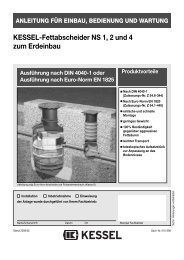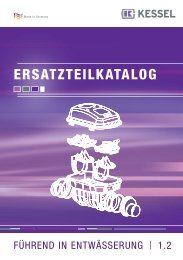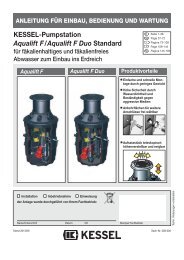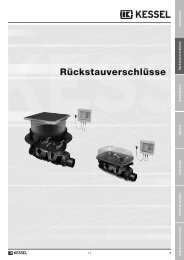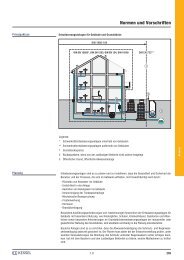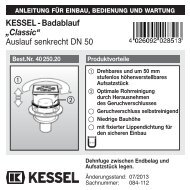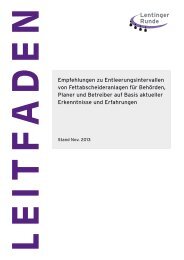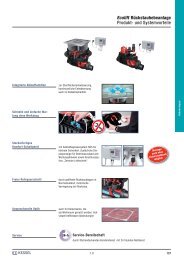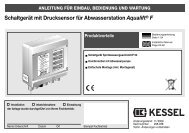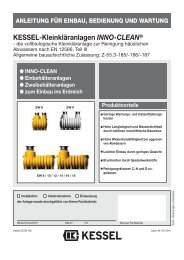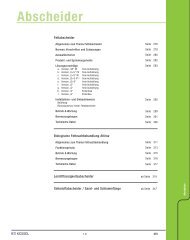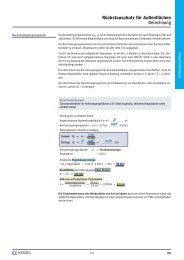KESSEL - Leichtflüssigkeitsabscheider
KESSEL - Leichtflüssigkeitsabscheider
KESSEL - Leichtflüssigkeitsabscheider
Erfolgreiche ePaper selbst erstellen
Machen Sie aus Ihren PDF Publikationen ein blätterbares Flipbook mit unserer einzigartigen Google optimierten e-Paper Software.
5. Installation and assembly<br />
During interim storage of the separator and up to the end<br />
of the installation work, suitable safety measures must be<br />
taken on the construction site to avoid accidents and damage<br />
to the light fluid separator.<br />
The Chapter Safety Instructions must be observed!<br />
5.1 Installation requirements<br />
The installation must be carried only by companies who have<br />
the necessary specialist experience, suitable equipment and<br />
adequately trained personnel for the task.<br />
The soil characteristics must be investigated for technical construction<br />
suitability (soil classification for technical construction<br />
purposes, DIN 18196). The maximum ground water level likely<br />
to occur must also be established. The ground water level must<br />
not exceed the level of the outlet. Adequate drainage of seepage<br />
water is also essential in the case of soils impermeable to<br />
water. The types of stresses occurring, such as maximum traffic<br />
loads and installation depth, must also be clarified.<br />
The separators for ground installation should be installed outside<br />
the building, as near as possible to the outlets. If necessary,<br />
the connection pipes of the inlets to the separator should<br />
be laid with heat insulation, or heated. The required frost-free<br />
installation depth is achieved by the use of telescopic attachment<br />
pieces, which also allows easy adjustment to feed and outlet<br />
pipes (drainage system). The covers for the load classes A<br />
/ B and D are not bolted and comply with EN 124.<br />
Separator systems must be installed close to the point of origin<br />
of the light fluids. They must be easily accessible for cleaning<br />
and maintenance purposes.<br />
The use of locked or ventilated covers is prohibited.<br />
Pump or lifting systems must not be installed in the supply line<br />
in front of the separator. If these are necessary, they must be installed<br />
after the separator.<br />
For the reliable operation of the system, <strong>KESSEL</strong> recommends<br />
the installation of a projection, and also a warning system. The<br />
necessary fitting requirements must be provided before filling<br />
of the construction pit.<br />
Separator systems must be installed so that the upper edge of<br />
the covers is sufficiently high in comparison to the made level<br />
of the surfaces to be drained (see Figure 1).<br />
edge of the lowest connected outlet. The necessary projection<br />
depends on the nominal size of the separator (see Chapter on<br />
Technical Data).<br />
If this excess height cannot be maintained, a warning device for<br />
light fluids must be installed.<br />
Drainage area<br />
Elevated area<br />
Illustration 1<br />
Separator system ready for use<br />
Surface level covers<br />
Light fluid separators must be protected against reverse flow<br />
from the drainage system.<br />
<strong>KESSEL</strong> recommend the following protective precautions:<br />
Outlet point Separator Reverse flow protection<br />
Inside a building Projection Reverse flow closure<br />
available<br />
Inside a building No projection Reverse flow closure<br />
Outside a building Projection Reverse flow closure<br />
available<br />
Outside a building No projection Lifting system<br />
Please Note:<br />
Weather influences or cooling of the chamber during installation<br />
(due to filling with cold water) could result in slight dimensional<br />
changes of separators, wastewater treatment systems<br />
and rainwater storage tanks in comparison with dimensions<br />
listed in catalogs or drawings. Before installation of the<br />
chamber it is recommended that the exact dimensions of the<br />
chamber being installed (especially the chamber height) is<br />
checked.<br />
The fluid level in the separator is always higher than the water<br />
level in the drainage system due to the difference in density between<br />
light fluid and water.<br />
The definitive level is the highest possible standing rainwater<br />
height, when dirty water and rainwater are channelled together.<br />
If only dirty water is being fed in, the definitive level is the upper<br />
34



